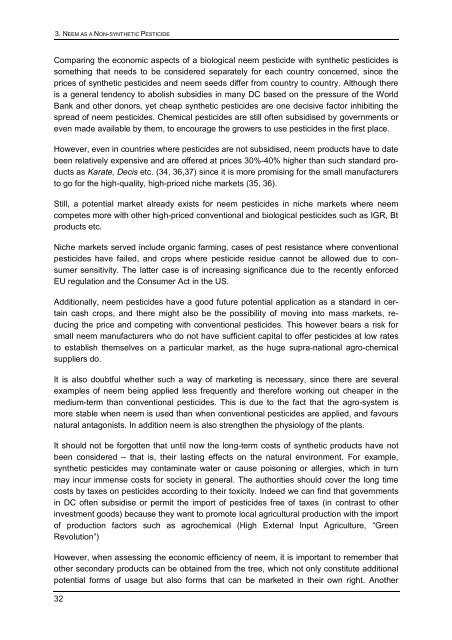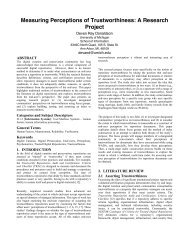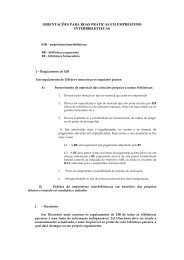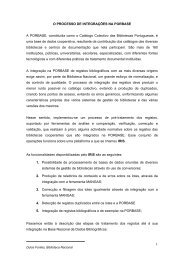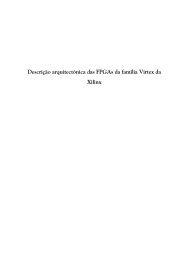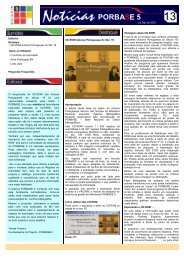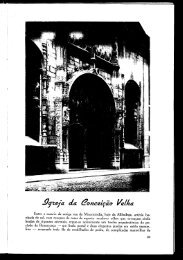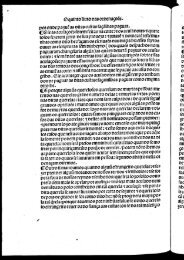Status report on global Neem usage - Biblioteca Nacional de Portugal
Status report on global Neem usage - Biblioteca Nacional de Portugal
Status report on global Neem usage - Biblioteca Nacional de Portugal
Create successful ePaper yourself
Turn your PDF publications into a flip-book with our unique Google optimized e-Paper software.
3. NEEM AS A NON-SYNTHETIC PESTICIDE<br />
Comparing the ec<strong>on</strong>omic aspects of a biological neem pestici<strong>de</strong> with synthetic pestici<strong>de</strong>s is<br />
something that needs to be c<strong>on</strong>si<strong>de</strong>red separately for each country c<strong>on</strong>cerned, since the<br />
prices of synthetic pestici<strong>de</strong>s and neem seeds differ from country to country. Although there<br />
is a general ten<strong>de</strong>ncy to abolish subsidies in many DC based <strong>on</strong> the pressure of the World<br />
Bank and other d<strong>on</strong>ors, yet cheap synthetic pestici<strong>de</strong>s are <strong>on</strong>e <strong>de</strong>cisive factor inhibiting the<br />
spread of neem pestici<strong>de</strong>s. Chemical pestici<strong>de</strong>s are still often subsidised by governments or<br />
even ma<strong>de</strong> available by them, to encourage the growers to use pestici<strong>de</strong>s in the first place.<br />
However, even in countries where pestici<strong>de</strong>s are not subsidised, neem products have to date<br />
been relatively expensive and are offered at prices 30%-40% higher than such standard products<br />
as Karate, Decis etc. (34, 36,37) since it is more promising for the small manufacturers<br />
to go for the high-quality, high-priced niche markets (35, 36).<br />
Still, a potential market already exists for neem pestici<strong>de</strong>s in niche markets where neem<br />
competes more with other high-priced c<strong>on</strong>venti<strong>on</strong>al and biological pestici<strong>de</strong>s such as IGR, Bt<br />
products etc.<br />
Niche markets served inclu<strong>de</strong> organic farming, cases of pest resistance where c<strong>on</strong>venti<strong>on</strong>al<br />
pestici<strong>de</strong>s have failed, and crops where pestici<strong>de</strong> residue cannot be allowed due to c<strong>on</strong>sumer<br />
sensitivity. The latter case is of increasing significance due to the recently enforced<br />
EU regulati<strong>on</strong> and the C<strong>on</strong>sumer Act in the US.<br />
Additi<strong>on</strong>ally, neem pestici<strong>de</strong>s have a good future potential applicati<strong>on</strong> as a standard in certain<br />
cash crops, and there might also be the possibility of moving into mass markets, reducing<br />
the price and competing with c<strong>on</strong>venti<strong>on</strong>al pestici<strong>de</strong>s. This however bears a risk for<br />
small neem manufacturers who do not have sufficient capital to offer pestici<strong>de</strong>s at low rates<br />
to establish themselves <strong>on</strong> a particular market, as the huge supra-nati<strong>on</strong>al agro-chemical<br />
suppliers do.<br />
It is also doubtful whether such a way of marketing is necessary, since there are several<br />
examples of neem being applied less frequently and therefore working out cheaper in the<br />
medium-term than c<strong>on</strong>venti<strong>on</strong>al pestici<strong>de</strong>s. This is due to the fact that the agro-system is<br />
more stable when neem is used than when c<strong>on</strong>venti<strong>on</strong>al pestici<strong>de</strong>s are applied, and favours<br />
natural antag<strong>on</strong>ists. In additi<strong>on</strong> neem is also strengthen the physiology of the plants.<br />
It should not be forgotten that until now the l<strong>on</strong>g-term costs of synthetic products have not<br />
been c<strong>on</strong>si<strong>de</strong>red – that is, their lasting effects <strong>on</strong> the natural envir<strong>on</strong>ment. For example,<br />
synthetic pestici<strong>de</strong>s may c<strong>on</strong>taminate water or cause pois<strong>on</strong>ing or allergies, which in turn<br />
may incur immense costs for society in general. The authorities should cover the l<strong>on</strong>g time<br />
costs by taxes <strong>on</strong> pestici<strong>de</strong>s according to their toxicity. In<strong>de</strong>ed we can find that governments<br />
in DC often subsidise or permit the import of pestici<strong>de</strong>s free of taxes (in c<strong>on</strong>trast to other<br />
investment goods) because they want to promote local agricultural producti<strong>on</strong> with the import<br />
of producti<strong>on</strong> factors such as agrochemical (High External Input Agriculture, “Green<br />
Revoluti<strong>on</strong>”)<br />
However, when assessing the ec<strong>on</strong>omic efficiency of neem, it is important to remember that<br />
other sec<strong>on</strong>dary products can be obtained from the tree, which not <strong>on</strong>ly c<strong>on</strong>stitute additi<strong>on</strong>al<br />
potential forms of <strong>usage</strong> but also forms that can be marketed in their own right. Another<br />
32


